
Composting and Recycling
Aerobic or anaerobic composting
- Kitchen and garden waste can be composted using earthworms like Eisenia foetida, Eudrilus Eugeniae or Perionyx excavates to produce rich vermi-compost. If you have garden space, dig a pit about 3 feet deep in a shady spot, put some cowdung at the bottom in one half of it and keep adding your kitchen and garden waste, covering each layer with some of the soil that was dug up to make the pit. Remember to remove the stones from it. Keep it damp and shady by covering it with some gunny bags or with cardboard. When one half is full, start filling the second half in the same way. After about six weeks, the worms will have converted the waste in the first half into manure which you can use for your plants.
- If you do not have garden space, you can use the bokashi method to start the composting process in a bucket in your kitchen. This Japanese method of inoculating waste with effective microorganisms that pickle it prevents waste from rotting and producing foul odours. The important thing is to keep both the inoculant and your bokashi buckets airtight (Yes, you need two buckets). Here’s how to go about it.
Convert two 20 litre paint buckets as shown in this video.
Make the inoculum or activator from lactobacillus enriched saw dust or rice husks as described in this document - Bokashi Innoculum.
- Keep all your kitchen waste separately. Once a day put it in your bokashi bucket putting two handfuls of the inoculant over each two to three inch thick layer of waste. Press down firmly with a plastic bag and cover the bucket tightly. The bag will prevent the air in the top of the bucket from entering the waste. After a few days, liquid will collect in the bottom of the bucket. This “Bokashi tea” is very good fertiliser and should be diluted with 10 parts water and immediately used on indoor or outdoor plants or used to clean drains or added to septic tanks. When the bucket is full, keep it aside and start on the next. Continue to drain the liquid daily.
- After two weeks, the waste in the first bucket will have fermented but it will not have disintegrated. You will need to take it to the composting site in your neighbourhood or to a friend who has a compost pit or to the Green Hills composting team. Earthworms love the fermented waste and will break it down in a week’s time yielding excellent compost.
- Metro cities are encouraging housing societies to compost their wet waste and create terrace gardens to grow their own vegetables, fruits and herbs. This is known as urban farming.
- All types of plastic waste can be shredded and melted in an extruder to produce pellets that can then be moulded into useful goods like buckets, basins and pipes, as at this factory in Kathgodam.
-
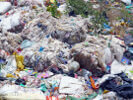
-
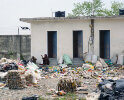
-
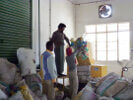
-

- In Coimbatore, a company called R-Cube makes UV resistant roofing sheets, roof tiles and pavers from HDPE and PP plastic waste.
- In 2017-18, Green Hills collected 10 tonnes of plastic waste from Almora town. It was used to build five kilometres of road in Almora district, roads that remain in very good condition. Using waste plastic in road construction solves two problems simultaneously – it reduces pollution and increases the durability and load-bearing capacity of roads. This simple process has been applied with success in several States in the South.
- Rain water harvesting is a simple but much neglected solution to the problem of water scarcity. Rain water runoff from roofs should be collected in covered water tanks that allow circulation of air but no light. Light causes algae to grow. Rain water can be stored for a whole year without chemicals and used for washing and irrigation. This article in Hindi posted on the Swach Bharat Local Circle suggests ways in which the government and citizens can work together to make the best use of rainwater and recharge diminishing ground water.
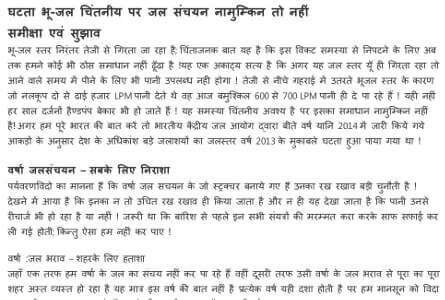
- As part of the government’s Swajal programme to build infrastructure for solid and liquid waste management in rural areas, Green Hills is demonstrating recycling of waste water for irrigation using grease filters, anaerobic baffle reactors and root zone treatment with Canna Indica.
-
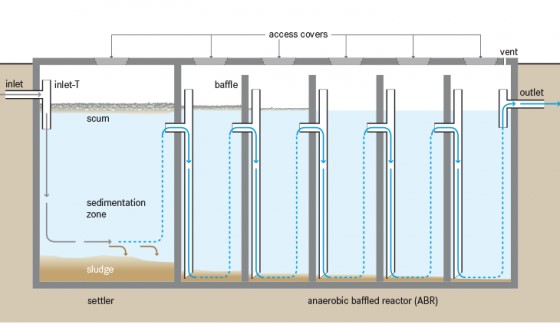
Sedimentation zone and Anaerobic Baffle Reactor - The influent can be aerated by an inlet cascade to support oxygen-dependent processes.
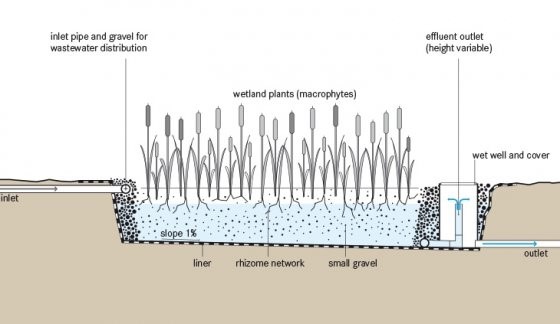
Horizontal Constructed Wet Land
